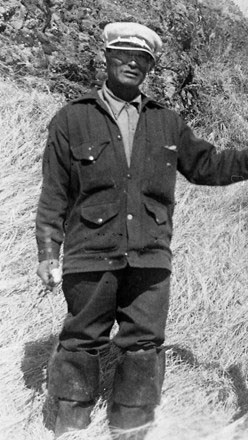Last updated: February 6, 2019
Article
Dena'ina Athabascan Snowshoes

These snowshoes were made by Wassillie Trefon in 1957 for his eldest son Henry. Snowshoes are incredibly important for the Dena'ina of the Lake Clark area. These, now part of Lake Clark National Park & Preserve's museum collection, are a beautiful example of a traditionally crafted Athabascan hunting-style snowshoe using local birch for the frames. The red paint on these snowshoes is in keeping with the long-standing tradition of painting snowshoes with red ochre so, in part, the blood stains from animals taken on hunting trips would not show.
Making snowshoes like these is time consuming and requires a great deal of knowledge. The artisan must know how to select the right birch tree, how to best chop it down, bend the frame, carve the wood, make the moose or caribou lacings, and weave the complex patterns of the webbing. In addition, the artisan must understand the science behind what different styles and shapes are needed for different people, activities, and snow conditions. Snowshoe makers develop their own personal style based on what they saw, who they learned from, and their personal preferences.

Wassillie became a skilled craftsman through many years of practice and unspoken teachings and refinement of the craft passed down from generations of his elders. Wassilie was born and raised at Dilah Vena ("fish swim in lake) known popularly today as Telaquana Lake in 1898. He was a hunter, trapper, dog musher, and skilled woodsman known for his craftmanship in all the traditional Dena'ina woodworking craft that were still part and parcel of most Dena'ina men born in the late nineteenth century. This included building snowshoes as well as sleds, cabins, caches, and boats.
Today, traditional snowshoe-making is an endangered art, but thanks to objects like this in museum collections, elders and master craftsmen can learn how past generations made these items, and can continue to pass on the knowledge, stories, language, and traditions associated to the skills that are central to Athabascan people. Wassillie Trefon's son Bill and daughter-in-law Martha donated this pair to Lake Clark's museum collection in 2007 and they are now being preserved in the park's Anchorage collection.
